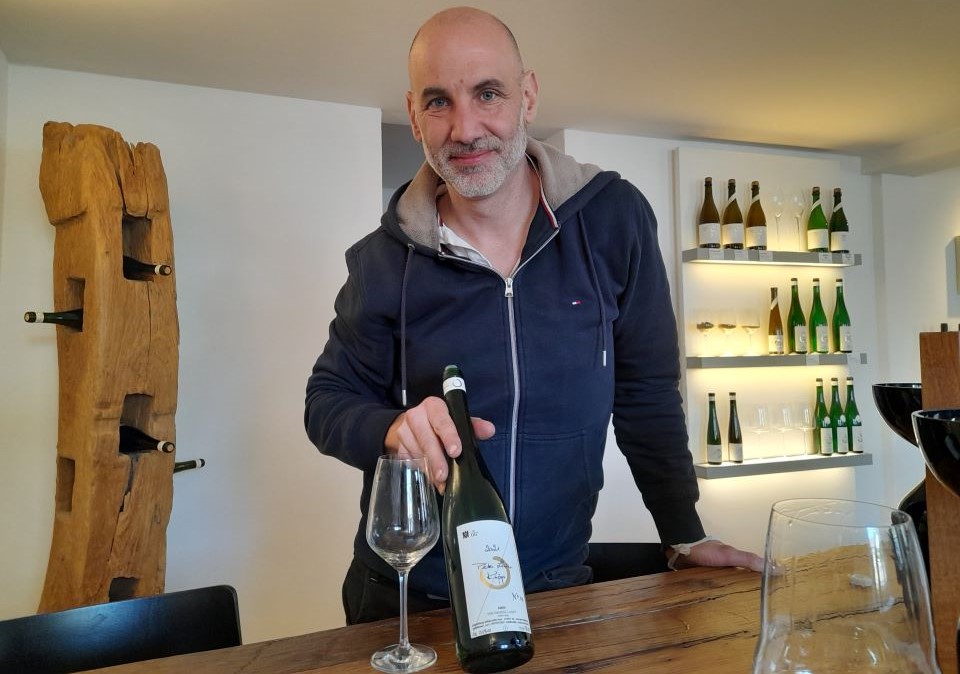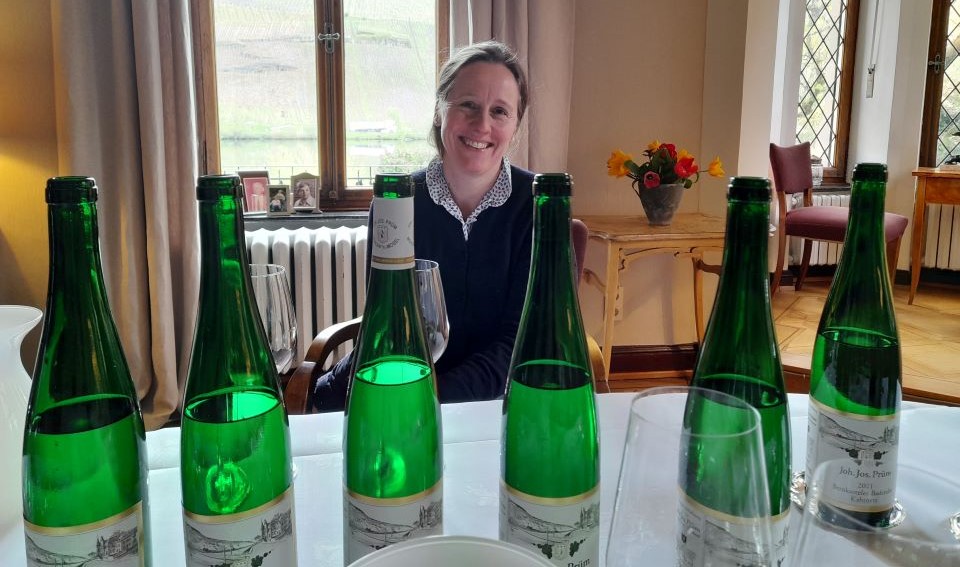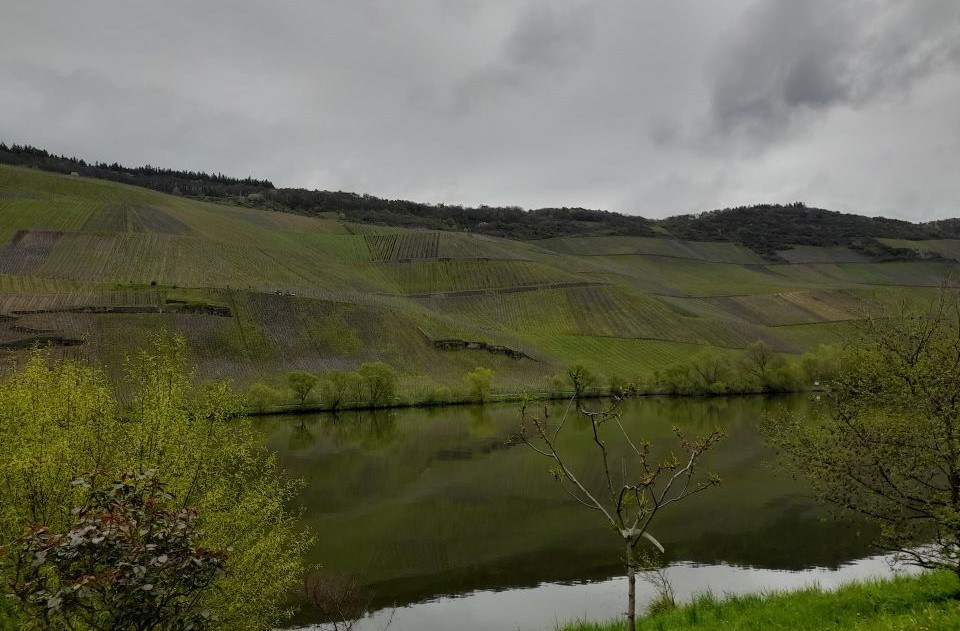Browse using the new Vinous website now. Launch →
Printed by, and for the sole use of . All rights reserved © 2015 Vinous Media
2021 Mosel and Saar – Tantalizing, Tingling, Thrilling
BY ANNE KREBIEHL MW | JUNE 13, 2023
Two thousand twenty-one was a fascinating vintage in Germany, so please forgive the alliterative headline—these attributes indeed define an interesting and outstanding year. An important note first: this is a brief report on a handful of important producers in Mosel and Saar before fuller German coverage resumes with the 2022 vintage in summer. David Schildknecht was unable to visit Mosel or Saar to taste the 2021s, hence this initial smaller, non-comprehensive foray into the world of Riesling grown on steep slate slopes – one of the world’s unique wine styles. In 2021, these wines came with a spine-tingling thrill and a freshness that harks back to glory vintages of the past. Two thousand twenty-one is a vintage for an enthusiastic “buy, buy, buy!” for all who love Riesling with real tension and drive – and that goes for dry, off-dry and sweet wines.

Cool, cool April - a Riesling vine in Wehlen, tied in the traditional heart-shape on a single stake, with buds only just burst.
The 2021 Vintage
“Two thousand twenty-one was a dream vintage for us,” said Matthias Knebel from Winningen in the Terrassenmosel when I asked his verdict at the VDP’s Weinbörse event in late April in Mainz. “If I could paint an ideal vintage, this would be it. I am a fan of fine-boned Riesling, and in vintages like 2018, 2019 and 2020, it was difficult to realize this style, whereas 2021 landed in our lap. We are so happy with this moderate ripeness and vivid, high acidity. It really was great for us.” This glowing review – given after the 2022 vintage, which was challenging for different reasons – does not mean 2021 was easy. On the contrary, growers had to be on their toes.
Two thousand twenty-one was distinctly cooler than the previous vintages, coming with copious rain, spelling disease pressure for Peronospora (downy mildew) and oidium (powdery mildew). “A demanding vintage that required much patience and selection,” is how the local growers’ association Moselwein e.V. put it. Biodynamic pioneer Clemens Busch from Pünderich in the Mittelmosel, who could not resort to systemic fungicides, was blunt: “We had extreme losses – we Ökos [an informal term for organic growers] were really affected and lost 50%. But wildly, most losses were in the entry-level and village-level wines, as the Grosse Lagen fared better because they are drier. Throughout the year, I had no idea how the wines would show, and once the wine was made, I was wowed. The quality of 2021 is wonderful for us, a classic Mosel vintage.” Across the region, losses were about 20-30%. Markus Molitor, who makes up to 130 different wines in more abundant years, made around 80.

Dorothee Zilliken's smile says it all: 2021 is a great and elegant vintage.
Dorothee Zilliken in the Saar gave a brief but insightful synopsis of the year in Saarburg: “We were so happy that the winter was very cold because nature really got to rest, and the vines entered deep dormancy. The frost also helps kill a few more pests, and really cold winters, even here in the Saar, are now rare. There was frost in early April, but that did not matter because no green shoots had appeared yet – that was lucky. Initially, we had a relatively cool summer and invested a lot of time in canopy management to ensure the best possible ventilation, removing leaves on the east side to expose the fruit to the fresh morning light rather than the hotter afternoon sun. There often was rain during summer – it felt like a wet, sad summer, but we got a really golden September. In 2021, harvest started on 11 October for the first time in years. There was no rain during harvest, and we had enough healthy grapes so that we could make a GG, something we were not able to do in 2020 because we did not have the requisite density in the grapes.”
Joh. Jos. Prüm only presented ten wines – three Kabinetts, four Spätlesen and three Auslesen – when there usually are four Auslesen and two to three Goldkapsels. Vineyard manager Marvin Bauer noted losses of 30% at the estate because Peronospora already got to the inflorescences, the part of the shoot that later turns into the grape bunch. July saw 160mm of rain when the monthly average is 60mm. The constant rain sent the vines into overdrive, so Bauer and his team gave their all to remain on top of their canopy management. It was “a constant race,” he said.
Katharina Prüm herself remarked that harvest quantities were “homeopathic,” or minuscule, after selection. Still, she followed this by saying: “None of us thought that we would experience such a cool vintage again. I could not be happier with 2021 because it is so classic. The wines are fun to drink now, but in 20 years’ time, they will have another dimension. This is Mosel. We are grateful for all the vintages, but if you want to show someone what the Mosel really is, the 2021 wines are the perfect example with their combination of elegance, tension, lightness and complexity.”
Markus Molitor calls 2021 “a touch more slender than we have gotten used to, a classic Mosel vintage with real tension. It reminded us of the top vintages of the 1990s. Acidity gives the wines so much stability and animation – just what we want.”
It was a great vintage for dry wines, Kabinett, Spätlesen and Auslesen – with next to no Beerenauslesen and Trockenbeerenauslesen.

Florian Lauer in his tasting room in Ayl.
Why 2021 Tastes So Thrilling
Timing was responsible for the extraordinary quality of the vintage. Budburst was not until early May, and flowering did not begin until mid-June, two weeks later than in 2020, completely removing any danger of the late spring frosts that devastated some French regions in 2021. While harvest for other varieties like Auxerrois and Pinots began in late September, a full month later than in hot 2020, Riesling enjoyed what it loves best: a long autumn. The weather remained patchy, but extended dry periods in September and October and some cool nights preserved acidity and allowed the grapes to develop their aromas fully without clocking up too much sugar.
Florian Lauer in the Saar observes that 2021 had more sunshine hours, allowing for more ripeness and aromatic development, differentiating it from even cooler vintages like 2010 and 2013. He shares, “In 2021, acid was not a problem; it was high but well buffered. Two thousand twenty-one is a vintage that can really be laid down.” This takes some explaining: how acidity is perceived in tasting correlates with pH levels. Received wisdom says that the cooler the region, the higher the acid and the lower the pH. So far, so logical – but also one-dimensional.

Katharina Prüm with her 2021 Rieslings and vineyards through the window in the background.
Why? Because there is another element in this subtle calibration: the vines’ water balance and supply. Water transports minerals like potassium, the most abundant in wine, alongside calcium and magnesium. The minerals are then accumulated in the grapes, buffering the pH level. The more water is available to the vine, the more minerals are deposited – which can be measured as alcohol-free dry extract in the resulting wine. Please note I am NOT talking about the much overused and ill-defined term “minerality”. These minerals buffer the pH and subtly increase it – which is incidentally also why skin-contact for Riesling is so popular in cooler years and a historical practice from a colder past: more potassium leeches out of the grape skins into the must, increasing the pH slightly and making it come across as less acidic. In a wet year like 2021, there were a lot of minerals in the grapes to buffer, giving these wines immense balance despite some high acid levels.
The opposite is true in very dry years, explaining why in a vintage like 2018, the pH levels remained relatively low for relatively high acid levels. The vines did not transport much water in their sap and could not deposit so many buffering minerals. This is why wines from dry years like 2022 “have less acid, but it is far more noticeable,” according to Peter Lauer. But back to 2021: I am not saying that these pH levels are high – I am saying that they are buffered and balanced. Where growers supplied this information, I have included some analytical values to show how exceptional 2021 is. Despite the cool year and the high acids, the wines come with full aromatic development and moderate alcohols while their elevated acids act like laser beams, illuminating every last vestige of flavor. All in all, this equates to heightened expression, real tension, absolute aging potential and haunting deliciousness for those who like it sleek and hair-raising.

Kegs of promise - tiny quantities of Beeren and Trockenbeerenauslesen fermenting away in the corner of the Markus Molitor tasting room.
What Else Is New?
After the past hot years’ discussions about the current outlines of classified vineyards, the 2021 vintage reinforced old hierarchies. The best sites for Riesling historically were those that allowed the grapes to ripen slowly but fully in a long, cool growing season. Naturally, these are the warmest sites, either wholly or partly south-facing. In the current climate, these Grosse Lagen often lead Riesling to suffer from dry stress in higher temperatures. Riesling can take higher temperatures as long as there is sufficient water, so it all boils down to water availability. Two thousand twenty-one re-established the old order: the best sites are well-drained and brought forth amazing wines. Clemens Busch (above) said as much. Florian Lauer noted that 2021 also returned another relic from the past: erosion – soil washed down from the steep slopes.
Other changes are afoot, too. Not least, the VDP tinkering with its regulations – as of 2022, Erste Lagen, or Premier Crus, were allowed in Mosel, Saar and Ruwer. My request for a list of newly classified Erste Lagen to the VDP was answered politely: it still is in progress, updates are to follow, and the information that will be published is still being finalized. I will hopefully know more in the summer. But that is small beer compared to the impending change of the German wine law. There will be much to report – as unintended consequences, contradictions and general confusion inevitably rear their heads. I had better get a supply of lively and refreshing Sekt to see me through the more theoretical parts of future reports covering Germany. Zum Wohl!

The green-grey color palette of moody late April weather in Wehlen.
I tasted most of the wines in this report at the VDP Weinbörse in Mainz in late April. Estate visits included stops at Joh. Jos. Prüm, Markus Molitor, Nik Weis St Urbans-Hof, Forstmeister Geltz-Zilliken, Peter Lauer and Van Volxem. The 2017 GG Réserves from Dr. Loosen were tasted at home in London upon their UK release in mid-April.
© 2023, Vinous. No portion of this article may be copied, shared or re-distributed without prior consent from Vinous. Doing so is not only a violation of our copyright, but also threatens the survival of independent wine criticism.
You Might Also Enjoy
Alsace 2021s and 2020s – A Late Arrival in the Pinot Noir Pantheon, Anne Krebiehl MW, April 2023
Alsace 2020s and 2021s: Just like Janus, Anne Krebiehl MW, April 2023
Saar Riesling 2019-2020: Selective Excellence, David Schildknecht, May 2022
Generosity and Diversity - Mosel 2018: Graach to Grünhaus, David Schildknecht, November 2020
Generous to a Fault, Mosel 2018: Winningen to Wehlen, David Schildknecht, August 2020
